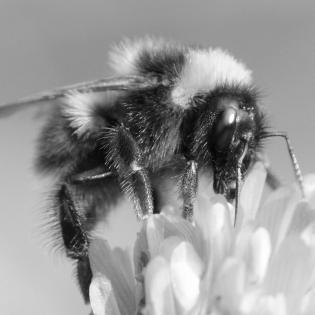Beneficial Bees - Middle School
Students learn about the roles of bees in a colony and discuss how that relates to people in community. Bees have an important role in nature as pollinators, but their population numbers have been declining in recent years. Students write a letter or create a flyer to teach others how to help bees by planting native species.
The learner will:
- research the part bees play in the reproduction of plants through pollination.
- discover the importance of bees to our food supply.
- learn about why bees are struggling to thrive.
- student copies of Reproduction in Plants handout
- copy of the PowerPoint slide show to facilitate this lesson (below)
- website references below
Use the attached PowerPoint to guide classroom discussion.
Students reread their own quick write from the Anticipatory Set. In small groups they discuss the following questions:
- How has your perception of bees changed?
- What did you learn about bees’ role in the reproduction of plants?
- How can your actions towards bees change others opinions?
- Amazon (2014). Bee & Me book. Retrieved from https://www.amazon.com/Bee-Me-Elle-J-McGuinness/dp/1449443710
- Environmental Protection Agency (2016). Colony Collapse Disorder. Retrieved from https://www.epa.gov/pollinator-protection/colony-collapse-disorder
- TED Talk (2013). Why are bees disappearing? Retrieved from https://www.ted.com/talks/marla_spivak_why_bees_are_disappearing?utm_content=awesm-publisher&utm_medium=on.ted.com-static&awesm=on.ted.com_MarlaSpivak&utm_campaign=&utm_source=pinterest.com
- University of Illinois Extension (2017). Facts of the Case: Flower Parts. Retrieved from https://web.extension.illinois.edu/gpe/case4/c4facts1a.html
- YouTube (2014). Why Do We Need Bees? Retrieved from https://www.youtube.com/watch?v=6CxCTyxRFh0
Instructions
Anticipatory Set: (5 minutes) Tap students' prior knowledge and spark their empathy to care about bees with the following Quick Write:
Display a picture of a bee on a flower. Tell students to take out a piece of paper and write for five to ten minutes about this picture. They may write about a memory that it brings, about how it makes them feel, make a list of words and emotions, or write about something they already know about the picture. Have them save the writing for later.
Give the lecture about bees from the PowerPoint below.
Discuss how human connections and community make us stronger together. Define community and brainstorm some communities we belong to.
- What are things that isolate people from their community, and what are the effects of being alone and not belonging?
- How does a healthy community help all of us and what are practices that make a community better?
Research the role bees play in the reproduction of plants through pollination. Students complete the handout “Reproduction in Plants” as they refer to this webpage at the University of Illinois Extension and other related resources.
Discuss the importance of bees to our food supply. Learn about why bees are struggling to thrive.
- Watch a 15-min. TED talk “Why Bees Are Disappearing” by Marla Spivak. Link
- Watch the YouTube video “Why Do We Need Bees?” to explain why bees are important and struggling to survive. Link
Discuss details of the video, readings, or book. Ask, “Why are bees important?” and “Why are bees struggling to survive?
Help students recognize that their actions can make a difference. Connect the welfare of bees to students’ lives and the community. How can philanthropic action bring social change?
Make a class list of things that may help bees thrive. Talk about one step the class can take together to help bees and ourselves.
Service Project
Option 1: Students write a persuasive letter to their principal or parents asking for permission to plant bee-friendly plants.
- Students brainstorm reasons why someone would want to have bees around.
- Learn the parts of a persuasive letter.
- Students write their letter and peer edit with each other.
- Send the final copy to the person they wrote it to on Earth Day.
- Going Further: If you can find funds and get permission, plant a few species around your school.
Option 2: Students create a handout informing and encouraging the community about planting species that will help pollinators in their area.
- Students research plants native to your area that are a good source of food for pollinators. Your local parks department or the soil and water conservation district are often good sources of information in this field.
- Make a chart of plants, where they grow best, and how to care for them.
- Each student chooses a plant and creates a handout about the plant and its care, and describing the importance of pollinators in your community.
Have a lily or other type of flower sitting at the front of the class with a magnifying glass beside it for students to examine as they turn in their assignment. It is beneficial for them to see the parts on an actual plant as well as on the computer.
Philanthropy Framework
-
Strand PHIL.I Definitions of Philanthropy
-
Standard DP 01. Define Philanthropy
-
Benchmark MS.4 Give examples of how individuals have helped others.
-
-
-
Strand PHIL.II Philanthropy and Civil Society
-
Standard PCS 01. Self, citizenship, and society
-
Benchmark MS.2 Discuss why some animals and humans will sacrifice for the benefit of unknown others.
-
-
Standard PCS 07. Skills of Civic Engagement
-
Benchmark MS.1 Identify and research public or social issues in the community, nation or the world related to the common good. Form an opinion, and develop and present a persuasive argument using communication tools.
-
-
-
Strand PHIL.IV Volunteering and Service
-
Standard VS 01. Needs Assessment
-
Benchmark MS.1 Identify a need in the school, local community, state, nation, or world.
-
-
